Terraced Landscapes as NBSs for Geo-Hydrological Hazard Mitigation: Towards a Methodology for Debris and Soil Volume Estimations through a LiDAR Survey
Abstract
:1. Introduction
2. Materials and Methods
2.1. The Study Area
2.2. Topographic Data
2.3. Research Workflow
2.3.1. Terrace Detection
- Based on the ALS terrain elevation data, a grid—called an input grid—was created. The input grid consisted of columns and rows, where a node containing terrain-elevation information for that position was placed at every node.
- The input grid was considered to consist of a group of columns, that is, the concept of row was put aside; the group of columns contains the same information that is contained in the input grid.
- Terrain elevation figures along every column were considered as being seismic wave amplitude data. Then, each column was considered as being a seismic trace (ST) composed of amplitude figures.
- Thus, by considering one ST at a time and applying a set of seismic data processing algorithms to the ST, weak or subtle events occurring at each ST were enhanced; these subtle events correspond to the weak topographic features contained in the input grid. The same set of enhancement algorithms was applied to all STs.
- After being processed, all STs were placed back in the same position as in the input grid obtaining a new grid where the weak topographic features contained in the original grid appeared enhanced. This new resulting grid is called a ground ALS-derived grid with LIHA applied.
2.3.2. Volume Estimation
3. Results
3.1. Terrace Identification Error Assessment
3.2. Terraces’ Identification and Volume Estimation
4. Discussion
5. Conclusions
Author Contributions
Funding
Conflicts of Interest
References
- Lasanta, T.; Arnáez, J.; Oserín, M.; Ortigosa, L.M. Marginal lands and erosion in terraced fields in the Mediterranean mountains. A case study in the Camero Viejo (Northwestern Iberian System, Spain). Mt. Res. Dev. 2001, 21, 69–76. [Google Scholar] [CrossRef] [Green Version]
- Cao, Y.; Wu, Y.; Zhang, Y.; Tian, J. Landscape pattern and sustainability of a 1300-year-old agricultural landscape in subtropical mountain areas, Southwestern China. Int. J. Sustain. Dev. World Ecol. 2013, 20, 349–357. [Google Scholar] [CrossRef]
- Tarolli, P.; Preti, F.; Romano, N. Terraced landscapes: From an old best practice to a potential hazard for soil degradation due to land abandonment. Anthropocene 2014, 6, 10–25. [Google Scholar] [CrossRef]
- Saiz, G.; Wandera, F.M.; Pelster, D.E.; Ngetich, W.; Okalebo, J.R.; Rufino, M.C.; Butterbach-Bahl, K. Long-term assessment of soil and water conservation measures (Fanya-juu terraces) on soil organic matter in South Eastern Kenya. Geoderma 2016, 274, 1–9. [Google Scholar] [CrossRef]
- Pijl, A.; Wang, W.; Straffelini, E.; Tarolli, P. Soil and water conservation in terraced and non-terraced cultivations: An extensive comparison of 50 vineyards. Land Degrad. Dev. 2022, 33, 596–610. [Google Scholar] [CrossRef]
- Stanchi, S.; Freppaz, M.; Agnelli, A.; Reinsch, T.; Zanini, E. Properties, best management practices and conservation of terraced soils in Southern Europe (from Mediterranean areas to the Alps): A review. Quat. Int. 2012, 265, 90–100. [Google Scholar] [CrossRef] [Green Version]
- Ghersi, A.; Ghiglione, G. Paesaggi Terrazzati I Muretti a Secco Nella Tradizione Rurale Ligure; Piviere, I., Ed.; Il Piviere: Gavi, Italy, 2012. [Google Scholar]
- Wei, W.; Chen, D.; Wang, L.; Daryanto, S.; Chen, L.; Yu, Y.; Lu, Y.; Sun, G.; Feng, T. Global synthesis of the classifications, distributions, benefits and issues of terracing. Earth-Sci. Rev. 2016, 159, 388–403. [Google Scholar] [CrossRef] [Green Version]
- Paliaga, G.; Giostrella, P.; Faccini, F. Terraced landscape as cultural and environmental heritage at risk: An example from Portofino Park (Italy). ANNALES Ser. Hist. Sociol. 2016, 26, 513–522. [Google Scholar]
- Sereni, E. Storia del Paesaggio Agrario Italiano; Edizioni Laterza: Bari, Italy, 1961. [Google Scholar]
- Greppi, C. Ciglionamenti e Terrazzamenti Nella Toscana Centrale: Dal Passato al Futuro. Paesaggi Terrazzati: Culture e Esperienze a Confronto, Venezia. 2007. Available online: https://www.yumpu.com/it/document/read/17510232/ciglionamenti-e-terrazzamenti-della-toscana-centrale-dal-passato- (accessed on 10 December 2021).
- Thirgood, J.V. Man and the Mediterranean Forest; Academic Press: London, UK, 1981. [Google Scholar]
- Agnoletti, M.; Errico, A.; Santoro, A.; Dani, A.; Preti, F. Terraced Landscapes and Hydrogeological Risk. Effects of Land Abandonment in Cinque Terre (Italy) during Severe Rainfall Events. Sustainability 2019, 11, 235. [Google Scholar] [CrossRef] [Green Version]
- Garcia-Ruiz, J.M.; Lasanta-Martinez, T. Land-use changes in the Spanish Pyrenees. Mt. Res. Dev. 1990, 10, 267–279. [Google Scholar] [CrossRef] [Green Version]
- Harden, C.P. Interrelationships between land abandonment and land degradation: A case from the Ecuadorian Andes. Mt. Res. Dev. 1996, 16, 274–280. [Google Scholar] [CrossRef]
- Kamada, M.; Nakagoshi, N. Influence of cultural factors on landscapes of mountainous farm villages in western Japan. Landsc. Urban Plan. 1997, 37, 83–90. [Google Scholar] [CrossRef]
- MacDonald, D.; Crabtree, J.R.; Wlesinger, G.; Dax, T.; Stamou, N.; Fleury, P.; Lazplta, J.G.; Gibon, A. Agricultural abandonment in mountain areas of Europe: Environmental consequences and policy response. J. Environ. Manag. 2000, 59, 47–69. [Google Scholar] [CrossRef]
- García-Ruiz, J.M.; Lana-Renault, N. Hydrological and erosive consequences of farmland abandonment in Europe, with special reference to the Mediterranean region—A review. Agric. Ecosyst. Environ. 2011, 140, 317–338. [Google Scholar] [CrossRef]
- Arévalo, J.R.; Fernández-Lugo, S.; Reyes-Betancort, J.A.; Tejedor, M.; Jiménez, C.; Díaz, F.J. Relationships between soil parameters and vegetation in abandoned terrace fields vs. non-terraced fields in arid lands (Lanzarote, Spain): An opportunity for restoration. Acta Oecol. 2017, 85, 77–84. [Google Scholar] [CrossRef]
- Rusterholz, H.-P.; Binggeli, D.; Baur, B. Successful restoration of abandoned terraced vineyards and grasslands in Southern Switzerland. Basic Appl. Ecol. 2020, 42, 35–46. [Google Scholar] [CrossRef]
- Giordan, D.; Cignetti, M.; Baldo, M.; Godone, D. Relationship between man-made environment and slope stability: The case of 2014 rainfall events in the terraced landscape of the Liguria region (Northwestern Italy). Geomat. Nat. Hazard. Risk 2017, 8, 1833–1852. [Google Scholar] [CrossRef] [Green Version]
- Brandolini, P.; Cevasco, A.; Capolongo, D.; Pepe, G.; Lovergine, F.; Del Monte, M. Response of terraced slopes to a very intense rainfall event and relationships with land abandonment: A case study from Cinque Terre (Italy). Land Degrad. Dev. 2018, 29, 630–642. [Google Scholar] [CrossRef]
- Preti, F.; Errico, A.; Caruso, M.; Dani, A.; Guastini, E. Dry-stone wall terrace monitoring and modelling. Land Degrad. Dev. 2018, 29, 1806–1818. [Google Scholar] [CrossRef]
- Paliaga, G.; Luino, F.; Turconi, L.; De Graff, J.V.; Faccini, F. Terraced landscapes on Portofino Promontory (Italy): Identification, geo-hydrological hazard and management. Water 2020, 12, 435. [Google Scholar] [CrossRef] [Green Version]
- Na, J.; Yang, X.; Fang, X.; Tang, G.; Pfeifer, N. Mapping artificial terraces from image matching point cloud in Loess Plateau of China. Int. Arch. Photogramm. Remote Sens. Spat. Inf. Sci. 2019, 42, 469–473. [Google Scholar] [CrossRef] [Green Version]
- Wei, Z.; Han, Y.; Li, M.; Yang, K.; Yang, Y.; Luo, Y.; Ong, S.H. A small UAV based multi-temporal image registration for dynamic agricultural terrace monitoring. Remote Sens. 2017, 9, 904. [Google Scholar] [CrossRef] [Green Version]
- Godone, D.; Giordan, D.; Baldo, M. Rapid mapping application of vegetated terraces based on high resolution airborne lidar. Geomat. Nat. Hazards Risk 2018, 9, 970–985. [Google Scholar] [CrossRef] [Green Version]
- Camera, C.; Djuma, H.; Bruggeman, A.A.; Zoumides, C.; Eliades, M.; Charalambous, K.; Abate, D.; Faka, M. Quantifying the effectiveness of mountain terraces on soil erosion protection with sediment traps and dry-stone wall laser scans. Catena 2018, 171, 251–264. [Google Scholar] [CrossRef]
- Cucchiaro, S.; Fallu, D.J.; Zhang, H.; Walsh, K.; Van Oost, K.; Brown, A.G.; Tarolli, P. Multiplatform-SfM and TLS data fusion for monitoring agricultural terraces in complex topographic and landcover conditions. Remote Sens. 2020, 12, 1946. [Google Scholar] [CrossRef]
- Diaz-Varela, R.A.; Zarco-Tejada, P.J.; Angileri, V.; Loudjani, P. Automatic identification of agricultural terraces through object-oriented analysis of very high resolution DSMs and multispectral imagery obtained from an unmanned aerial vehicle. J. Environ. Manag. 2014, 134, 117–126. [Google Scholar] [CrossRef] [PubMed]
- Cucchiaro, S.; Paliaga, G.; Fallu, D.J.; Pears, B.R.; Walsh, K.; Zhao, P.; Van Oost, K.; Snape, L.; Lang, A.; Brown, A.G.; et al. Volume estimation of soil stored in agricultural terrace systems: A geomorphometric approach. Catena 2021, 207, 105687. [Google Scholar] [CrossRef]
- Turconi, L.; Faccini, F.; Marchese, A.; Paliaga, G.; Casazza, M.; Vojinovic, Z.; Luino, F. Implementation of nature-based solutions for hydro-meteorological risk reduction in small Mediterranean catchments: The case of Portofino Natural Regional Park, Italy. Sustainability 2020, 12, 1240. [Google Scholar] [CrossRef] [Green Version]
- Faccini, F.; Gabellieri, N.; Paliaga, G.; Piana, P.; Angelini, S.; Coratza, P. Geoheritage map of the Portofino natural park (Italy). J. Maps 2018, 14, 87–96. [Google Scholar] [CrossRef]
- Faccini, F.; Piccazzo, M.; Robbiano, A.; Roccati, A. Applied Geomorphological Map of the Portofino municipal territory (Italy). J. Maps 2008, 4, 451–462. [Google Scholar] [CrossRef]
- Brancucci, G.; Paliaga, G. Geomorphic characterization of the main drainage basins of maritime Liguria (Italy)-preliminary results. Geogr. Fis. Din. Quat. 2005, 7 (Suppl. VII), 59–67. [Google Scholar]
- Sacchini, A.; Ferraris, F.; Faccini, F.; Firpo, M. Environmental climatic maps of Liguria. J. Maps 2012, 8, 199–207. [Google Scholar] [CrossRef] [Green Version]
- Paliaga, G.; Donadio, C.; Bernardi, M.; Faccini, F. High-resolution lightning detection and possible relationship with rainfall events over the Central Mediterranean Area. Remote Sens. 2019, 11, 1601. [Google Scholar] [CrossRef] [Green Version]
- Paliaga, G.; Parodi, A. Geo-Hydrological Events and Temporal Trends in CAPE and TCWV over the Main Cities Facing the Mediterranean Sea in the Period 1979–2018. Atmosphere 2022, 13, 89. [Google Scholar] [CrossRef]
- Faccini, F.; Piccazzo, M.; Robbiano, A. Natural hazards in San Fruttuoso of Camogli (Portofino Park, Italy): A case study of a debris flow in a coastal environment. Boll. Della Soc. Geol. Ital. 2009, 128, 641–654. [Google Scholar]
- Roccati, A.; Paliaga, G.; Luino, F.; Faccini, F.; Turconi, L. Rainfall Threshold for shallow landslides initiation and analysis of long-term rainfall trends in a Mediterranean area. Atmosphere 2020, 11, 1367. [Google Scholar] [CrossRef]
- Sofia, G.; Bailly, J.S.; Chehata, N.; Tarolli, P.; Levavasseur, F. Comparison of pleiades and LiDAR digital elevation models for terraces detection in farmlands. IEEE J. Sel. Top. Appl. Earth Obs. Remote Sens. 2016, 9, 1567–1576. [Google Scholar] [CrossRef] [Green Version]
- Saez, J.L.; Corona, C.; Stoffel, M.; Rovéra, G.; Astrade, L.; Berger, F. Mapping of erosion rates in marly badlands based on a coupling of anatomical changes in exposed roots with slope maps derived from LiDAR data. Earth Surf. Processes Landf. 2011, 36, 1162–1171. [Google Scholar] [CrossRef]
- De Tomasi, F.; Martano, P.; Miglietta, M.; Morabito, A.; Perrone, M.R. Lidar monitoring of water vapor and comparison with numerical simulations. Il Nuovo Cim. C 2003, 26, 373–385. [Google Scholar]
- Samodra, G.; Ramadhan, M.F.; Sartohadi, J.; Setiawan, M.A.; Christanto, N.; Sukmawijaya, A. Characterization of displacement and internal structure of landslides from multitemporal UAV and ERT imaging. Landslides 2020, 17, 2455–2468. [Google Scholar] [CrossRef]
- Ilinca, V.; Șandric, I.; Chițu, Z.; Irimia, R.; Gheuca, I. UAV applications to assess short-term dynamics of slow-moving landslides under dense forest cover. Landslides 2022, 19, 1717–1734. [Google Scholar] [CrossRef]
- Cebulski, J. Impact of river erosion on variances in colluvial movement and type for landslides in the Polish Outer Carpathians. Catena 2022, 217, 106415. [Google Scholar] [CrossRef]
- Freeman, G.T. Calculating Catchment Area with Divergent Flow Based on a Regular Grid. Comput. Geosci. 1991, 17, 413–422. [Google Scholar] [CrossRef]
- Furze, S.; O’Sullivan, A.M.; Allard, S.; Pronk, T.; Curry, R.A. A High-Resolution, Random Forest Approach to Mapping Depth-to-Bedrock across Shallow Overburden and Post-Glacial Terrain. Remote Sens. 2021, 13, 4210. [Google Scholar] [CrossRef]
- Klemen, Z.; Oštir, K.; Kokalj, Z. Sky-view factor as a relief visualization technique. Remote Sens. 2011, 3, 398–415. [Google Scholar]
- Kokalj, Ž.; Hesse, R. Airborne Laser Scanning Raster Data Visualization: A Guide to Good Practice; Založba ZRC: Ljubljana, Slovenia, 2017; pp. 1–90. [Google Scholar]
- Heipke, C.; Mayer, H.; Wiedemann, C.; Jamet, O. Automated reconstruction of topographic objects from aerial images using vectorized map information. Int. Arch. Photogramm. Remote Sens. Spec. Inf. Sci. 1997, 23, 47–56. [Google Scholar]
- Cohen, J. A coefficient of agreement for nominal scales. Educ. Psychol. Meas. 1960, 20, 37–46. [Google Scholar] [CrossRef]
- Cevasco, A.; Pepe, G.; Brandolini, P. The influences of geological and land use settings on shallow landslides triggered by an intense rainfall event in a coastal terraced environment. Bull. Eng. Geol. Environ. 2014, 73, 859–875. [Google Scholar] [CrossRef]
- Paliaga, G.; Faccini, F.; Luino, F.; Turconi, L. A spatial multicriteria prioritizing approach for geo-hydrological risk mitigation planning in small and densely urbanized Mediterranean basins. Nat. Hazards Earth Syst. Sci. 2019, 19, 53–69. [Google Scholar] [CrossRef] [Green Version]
- Moreno-de-las-Heras, M.; Lindenberger, F.; Latron, J.; Lana-Renault, N.; Llorens, P.; Arnáez, J.; Romero-Diaz, A.; Gallart, F. Hydro-geomorphological consequences of the abandonment of agricultural terraces in the Mediterranean region: Key controlling factors and landscape stability patterns. Geomorphology 2019, 333, 73–91. [Google Scholar] [CrossRef]
- Parodi, A.; Ferraris, L.; Gallus, W.; Maugeri, M.; Molini, L.; Siccardi, F.; Boni, G. Ensemble cloud-resolving modelling of a historic back-building mesoscale convective system over Liguria: The San Fruttuoso case of 1915. Clim. Past 2017, 13, 455–472. [Google Scholar] [CrossRef] [Green Version]
- Tarolli, P.; Pijl, A.; Cucchiaro, S.; Wei, W. Slope instabilities in steep cultivation systems: Process classification and opportunities from remote sensing. Land Degrad. Dev. 2021, 32, 1368–1388. [Google Scholar] [CrossRef]
- Kumar, P.; Debele, S.E.; Sahani, J.; Rawat, N.; Marti-Cardona, B.; Alfieri, S.M.; Basu, B.; Basu, A.S.; Bowyer, P.; Charizopoulos, N.; et al. An overview of monitoring methods for assessing the performance of nature-based solutions against natural hazards. Earth-Sci. Rev. 2021, 217, 103603. [Google Scholar] [CrossRef]
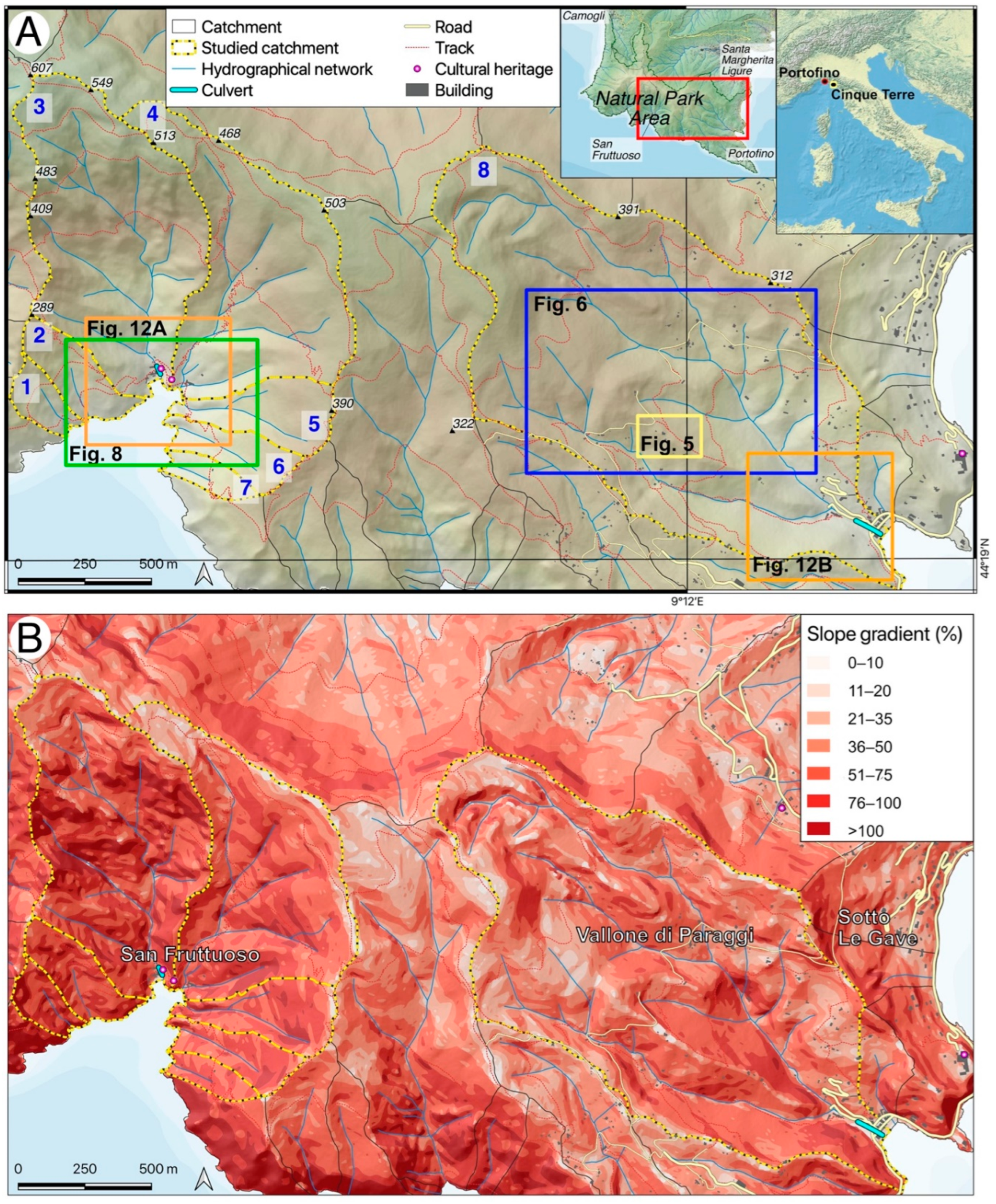
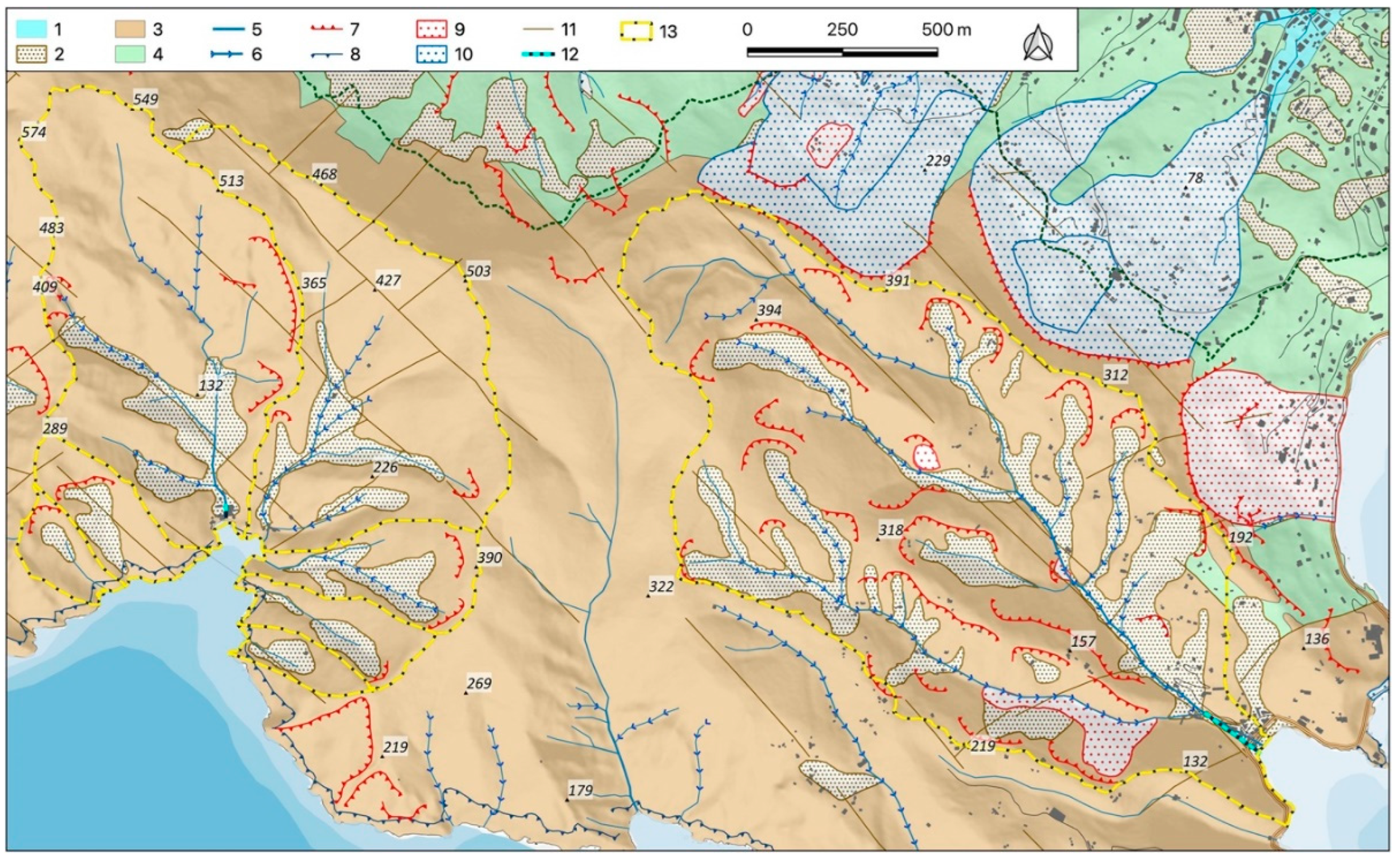

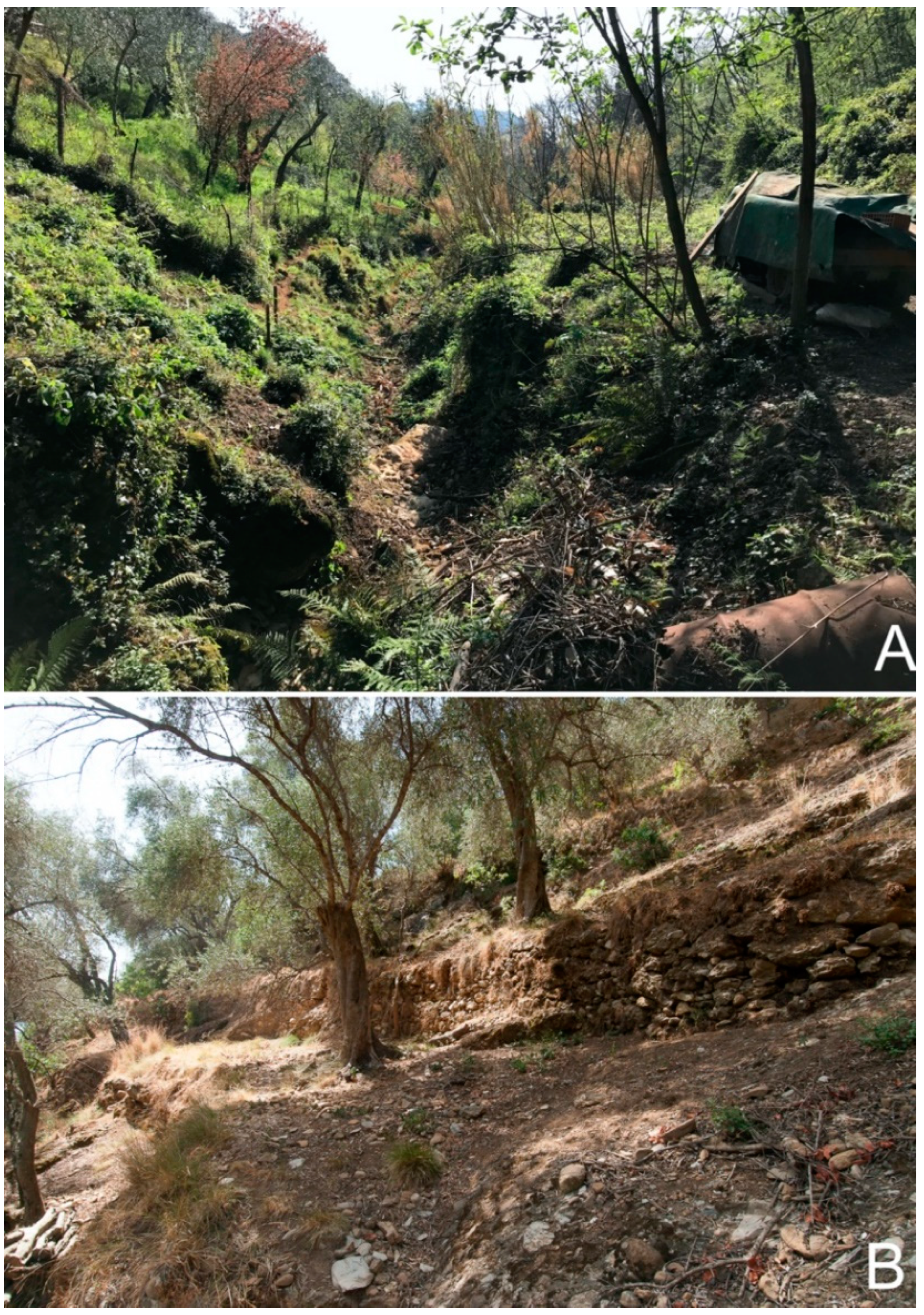
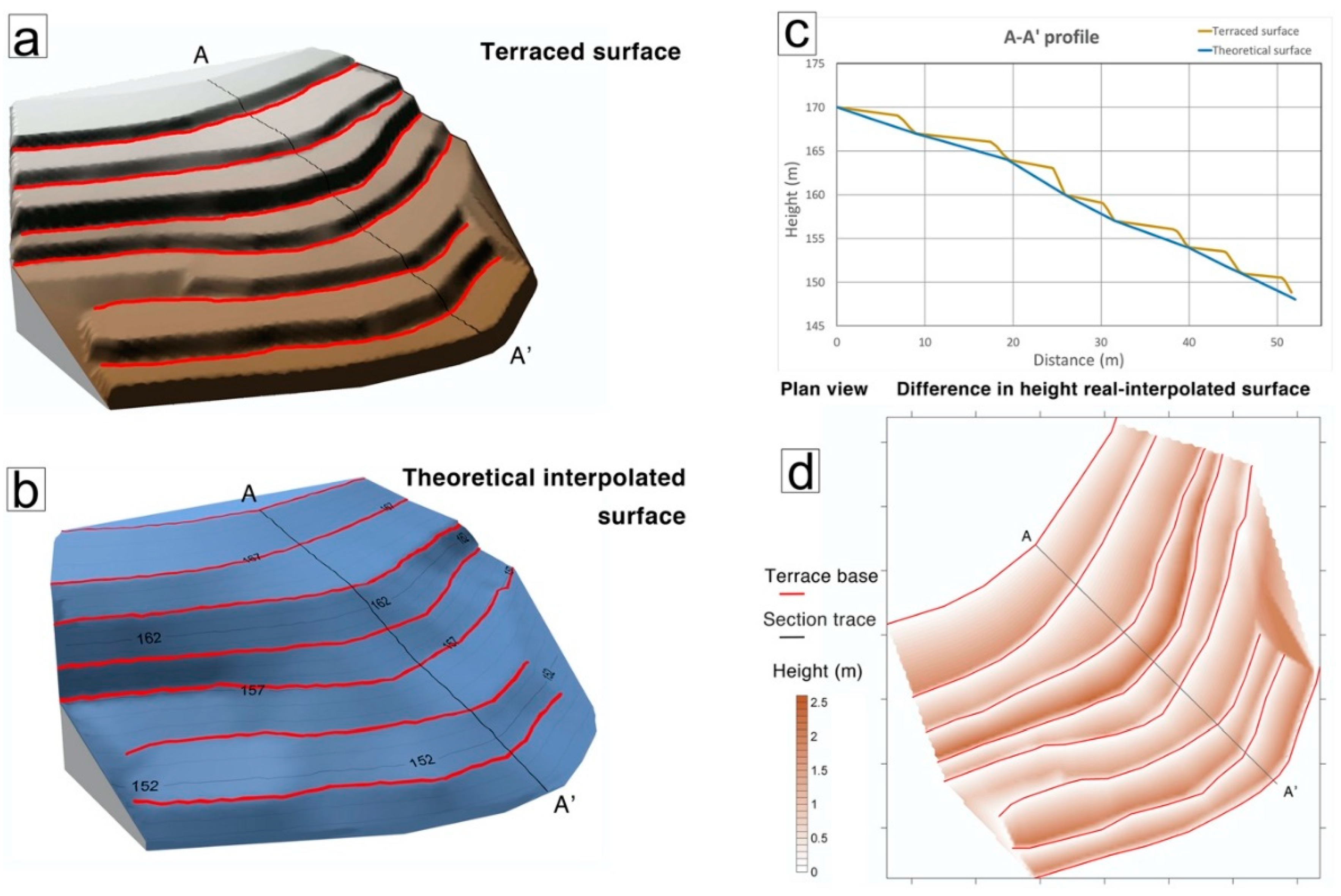




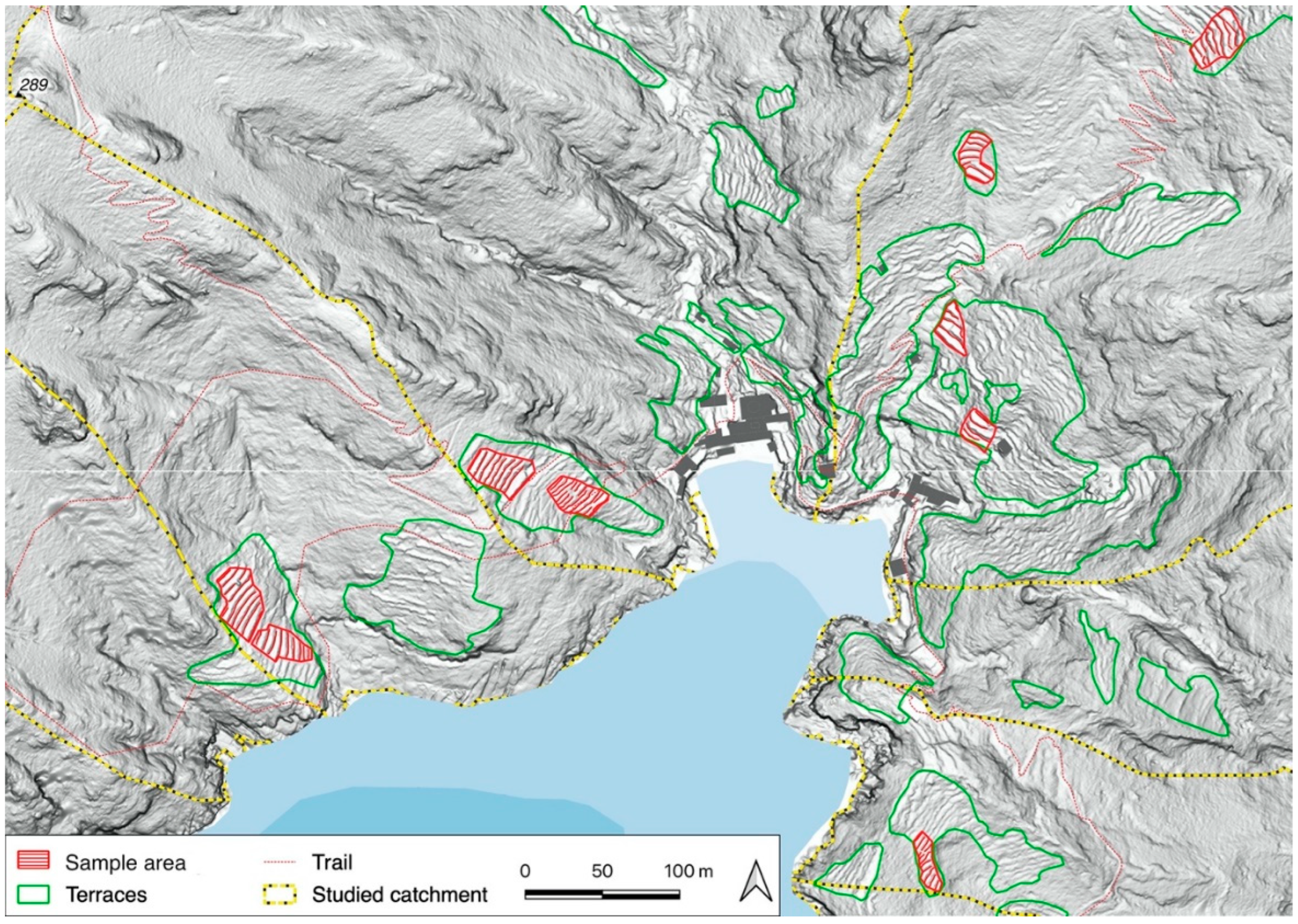

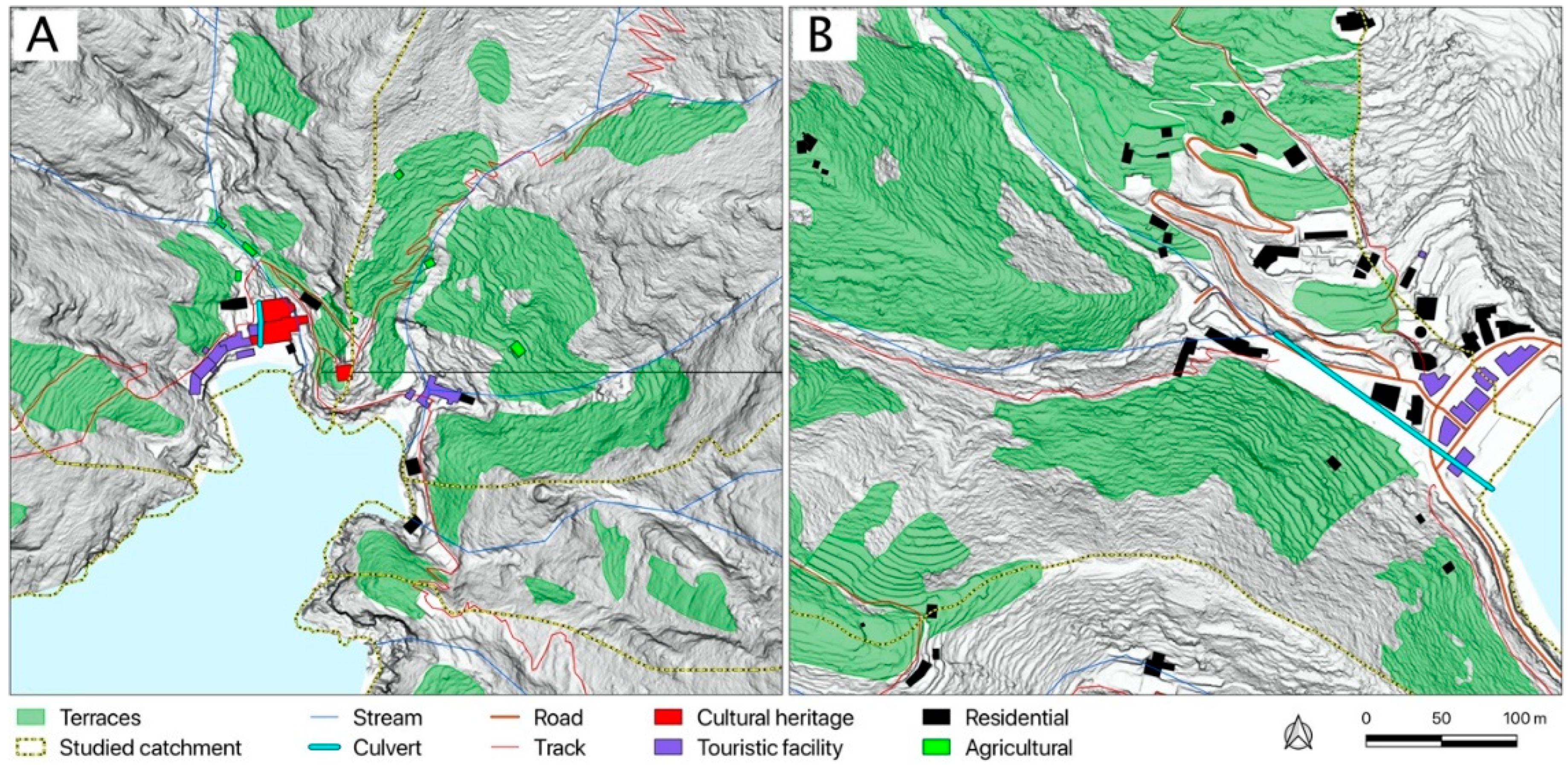
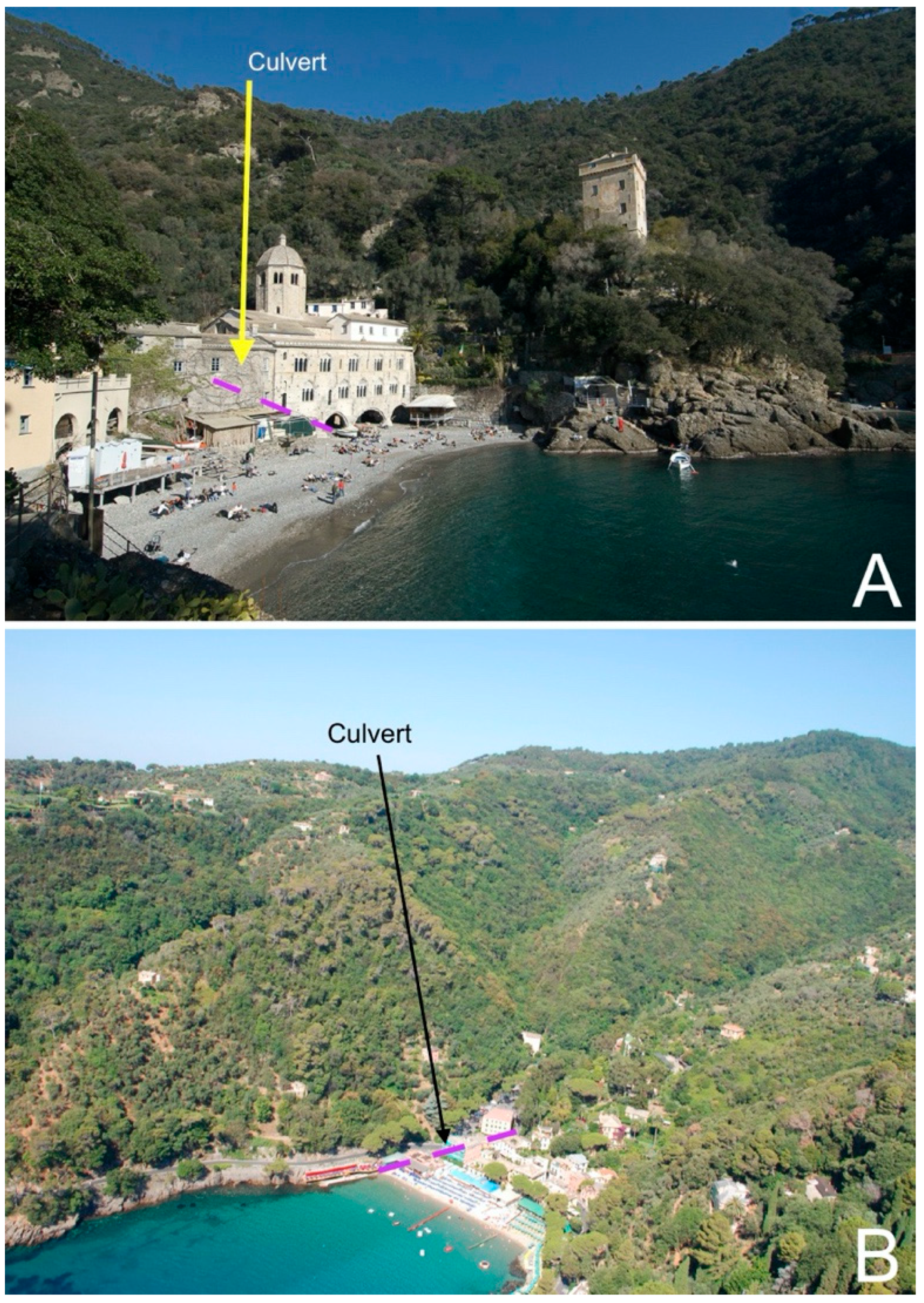
| Name | Scale/Pixel | Date |
|---|---|---|
| Buildings, Manufacts and Walls (CTR, 2nd Ed. 3D) | 1:5000 | 2007 |
| Hydrographic Network and Catchments | 1:10,000 | 2019 |
| Lithology | 1:10,000 | 2017 |
| Nature Reserve Borders | 1:10,000 | 2019 |
| Road Network—CTR 2nd Ed. 3D | 1:5000 | 2007 |
| Slope | 1:10,000 | 2016 |
| Trail Network | 1:25,000 | 2020 |
| Method | Q | K |
|---|---|---|
| SKF | 0.861 | 0.696 |
| LUC | 0.906 | 0.812 |
| LIHA | 0.954 | 0.932 |
| Catchment Nr. | Area (m2) | Q Mean (m) | Q Max (m) | Mean G (%) | Terraced Area (%) |
|---|---|---|---|---|---|
| 1 | 41,232 | 118 | 239 | 86 | 2.0 |
| 2 | 78,086 | 126 | 285 | 76 | 11.9 |
| 3 | 574,300 | 305 | 600 | 78 | 2.3 |
| 4 | 494,664 | 327 | 537 | 66 | 14.5 |
| 5 | 107,611 | 229 | 393 | 78 | 4.0 |
| 6 | 69,427 | 159 | 332 | 77 | 7.8 |
| 7 | 34,288 | 123 | 269 | 76 | 8.7 |
| 8 | 1,513,544 | 124 | 477 | 52 | 44.4 |
| Area | SV (m3/m2) | WSV (m3/m2) |
|---|---|---|
| Paraggi | 0.42 | 0.45 |
| San Fruttuoso | 0.43 | 0.39 |
| Catchment Nr. | Debris and Soil in Terraces (m3) | Catchment Specific Volume (m3/m2) |
|---|---|---|
| 1 | 323 | 0.008 |
| 2 | 3628 | 0.046 |
| 3 | 5159 | 0.009 |
| 4 | 28,002 | 0.057 |
| 5 | 1689 | 0.016 |
| 6 | 2115 | 0.030 |
| 7 | 1162 | 0.034 |
| 8 | 302,374 | 0.200 |
Publisher’s Note: MDPI stays neutral with regard to jurisdictional claims in published maps and institutional affiliations. |
© 2022 by the authors. Licensee MDPI, Basel, Switzerland. This article is an open access article distributed under the terms and conditions of the Creative Commons Attribution (CC BY) license (https://creativecommons.org/licenses/by/4.0/).
Share and Cite
Paliaga, G.; Luino, F.; Turconi, L.; Profeta, M.; Vojinovic, Z.; Cucchiaro, S.; Faccini, F. Terraced Landscapes as NBSs for Geo-Hydrological Hazard Mitigation: Towards a Methodology for Debris and Soil Volume Estimations through a LiDAR Survey. Remote Sens. 2022, 14, 3586. https://doi.org/10.3390/rs14153586
Paliaga G, Luino F, Turconi L, Profeta M, Vojinovic Z, Cucchiaro S, Faccini F. Terraced Landscapes as NBSs for Geo-Hydrological Hazard Mitigation: Towards a Methodology for Debris and Soil Volume Estimations through a LiDAR Survey. Remote Sensing. 2022; 14(15):3586. https://doi.org/10.3390/rs14153586
Chicago/Turabian StylePaliaga, Guido, Fabio Luino, Laura Turconi, Mario Profeta, Zoran Vojinovic, Sara Cucchiaro, and Francesco Faccini. 2022. "Terraced Landscapes as NBSs for Geo-Hydrological Hazard Mitigation: Towards a Methodology for Debris and Soil Volume Estimations through a LiDAR Survey" Remote Sensing 14, no. 15: 3586. https://doi.org/10.3390/rs14153586
APA StylePaliaga, G., Luino, F., Turconi, L., Profeta, M., Vojinovic, Z., Cucchiaro, S., & Faccini, F. (2022). Terraced Landscapes as NBSs for Geo-Hydrological Hazard Mitigation: Towards a Methodology for Debris and Soil Volume Estimations through a LiDAR Survey. Remote Sensing, 14(15), 3586. https://doi.org/10.3390/rs14153586












